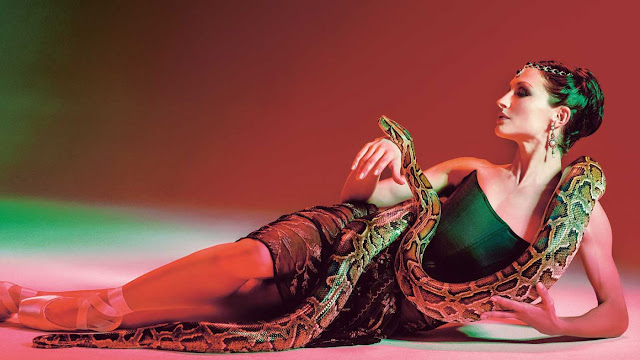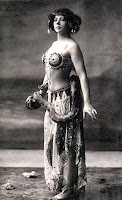The prima ballerina Anna Tsygankova as Margaretha Zelle MacLeod, a.k.a. Mata Hari, in the Dutch National Ballet’s production of 2016. Here, Mata Hari is portrayed as dancing with a snake, a popular story about her but, most likely, just a legend. It is the same for the legend that says she stripped naked in front of the firing squad at her execution, in 1917. The origin of both legends is hard to track down, but a turning point in their diffusion may have been the novel by E. Temple Thurston "Portrait of a Spy" published in 1929.
Mata Hari has turned out to be a myth-generating machine of incredible power. Myths which are pervasive, persistent, unstoppable, and - most often - completely false. Two of these myths are especially unlikely. One is that Mata Hari would sometimes perform her dances with a snake, the other that she bared her breasts in front of the firing squad that was going to kill her.
About the snake, it is not totally farfetched. We have pictures of dancers of the time of Mata Hari and sometimes they appear with snakes, as you can see here. This woman is often said to be Mata Hari, but she is not her, clearly. Yet, the legend of Mata Hari dancing with snakes is persistent. In addition to the image at the beginning of this post, it is described in Michelle Moran's recent novel "Mata Hari's Last Dance".
About the other legend, standing naked in front of the firing squad, it is not a common myth. We have no pictures of the execution, but most of the fantasy images created afterward show Mata Hari fully dressed and in a rather solemn attitude - or, sometimes, with a frightened expression.
Still, the legend exists. It is reported, among others, by Julie Wheelwright in her book "The Fatal Lover" (1992) (p. 3) in terms of a contemporary of Mata Hari, Natalie Barney, speaking of the "tawdry imagined sable coat over nude flesh invented by someone who wrote for the most scurrilous kind of literary weekly" It is mentioned also at this link.
I think it shouldn't take much effort to debunk both legends: there is no evidence anywhere - nothing at all - that Mata Hari ever danced with a snake. On the contrary, a descendant of her family, Ton Zelle, told me that "she hated snakes" - a rather likely attitude for a Dutch girl, born and raised in a place where snakes are not common - to say the least! About stripping naked in front of the firing squad, well, it doesn't even deserve to be debunked.
But these myths must have an origin: someone, somewhere, must have expressed them first. I haven't been able to find the "scurrilous literary weekly" described by Natalie Barnes, but I think it is possible to pinpoint the origin of both with the novel by E. Temple Thurston "Portrait of a Spy" appeared in 1929.
Today, Temple Thurston is nearly completely forgotten as a writer and perhaps for good reasons, at least judging from this novel. Not that it is poorly written, actually it shows the hand of a professional, the style reminds Faulkner, at times. But, as a novel, it just doesn't stand on its own. The protagonist, the British painter George Le Mesurier, doesn't ever gain life. Better, but still not satisfactory, is the female character inspired by Mata Hari. She goes under the name of Liane Sonrel (fictional alter ego of Margaretha Zelle) and Mada Garass (the fictional equivalent of Mata Hari). She is a character with some life, especially at the beginning. Apart from the different names, she goes through the same parable as Mata Hari, starting as a low-level stripper in Paris and in the end being shot. We read that, at the last moment,
. . . she flung open the folds of that sable coat and her body was gleaming naked to receive their bullets in her flesh.
As I said, not a good novel but, at least, Thurston created a myth that still lives today. It has been said in our time that propaganda "creates reality" and that was true also at the time of Mata Hari. Propaganda created the story of her being a dangerous spy and, in the process, people saw non-existing things, such as her dancing with snakes or appearing naked at her execution. In the end, all the madness, all the suffering, all the hate, love, folly, pain, joy, and misery are our creation. And I might cite Lafcadio Hearn in his "Out of the East"
We may have to learn that the infinite whirl of death and birth, out of which we cannot escape, is of our own creation, of our own seeking;—that the forces integrating worlds are the errors of the Past;—that the eternal sorrow is but the eternal hunger of insatiable desire;—and that the burnt-out suns are rekindled only by the inextinguishable passions of vanished lives.Vanished lives who still project on us their inextinguishable passion. Margaretha, you are still with us.






















